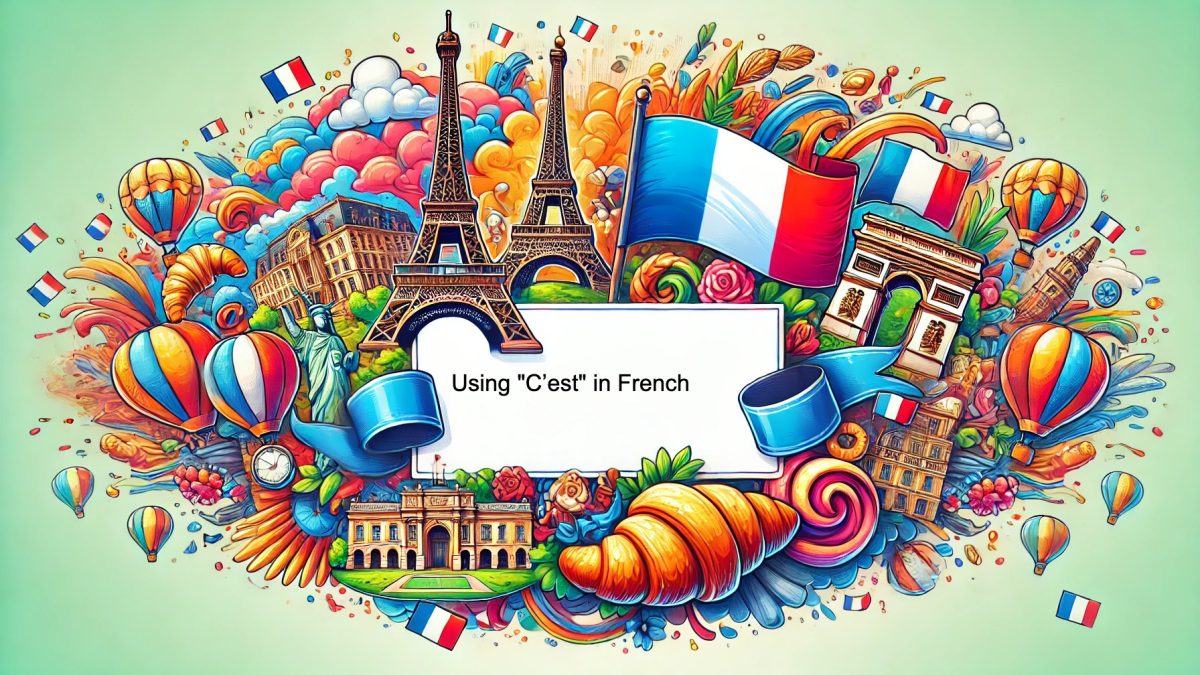Using “C’est” in French

Asking Simple Questions in French: A Comprehensive Guide for Beginners (Comment, Où, Pourquoi)
August 11, 2024
Understanding the Past Tense in French: A Comprehensive Guide to the Passé Composé
August 26, 2024Using “C’est” in French: A Comprehensive Guide for Beginners
One of the most versatile and frequently used phrases in French is “C’est.” For beginners at the A1 level, understanding how to use “C’est” correctly is essential for everyday conversations. “C’est” is an abbreviation of “Cela est,” which translates to “It is” or “This is” in English. This phrase is incredibly useful in a wide range of contexts, from identifying objects to expressing opinions. In this guide, we will explore the different uses of “C’est,” provide numerous examples, and offer tips on avoiding common mistakes. This comprehensive article is designed to help you master “C’est” and use it confidently in your French conversations.
What Does “C’est” Mean?
“C’est” is a contraction of “ce” (this/that) and “est” (is), and it is used to say “It is,” “This is,” or “That is.” It is a simple yet powerful phrase that you can use to point out or describe something, introduce people, or express an opinion.
Common Uses of “C’est”
- Identifying Objects and People:
- C’est + noun: Use “C’est” to identify or introduce someone or something.
- Example: C’est un livre. (It is a book.)
- Example: C’est mon ami. (This is my friend.)
- Expressing Opinions:
- C’est + adjective: Use “C’est” followed by an adjective to express your opinion about something.
- Example: C’est beau. (It is beautiful.)
- Example: C’est intéressant. (It is interesting.)
- Talking About Dates and Times:
- C’est + date/time: Use “C’est” to refer to dates, days, or times.
- Example: C’est lundi. (It is Monday.)
- Example: C’est le 1er janvier. (It is January 1st.)
- Describing Situations:
- C’est + phrase: Use “C’est” to describe a situation or summarize something.
- Example: C’est compliqué. (It is complicated.)
- Example: C’est la vie! (That’s life!)
- Introducing Facts:
- C’est + fact: Use “C’est” to present a fact or a piece of information.
- Example: C’est un fait connu. (It’s a known fact.)
- Example: C’est une vérité universelle. (It’s a universal truth.)
Detailed Breakdown of “C’est” Usage
1. Identifying Objects and People
When you want to identify or introduce something or someone, “C’est” is the go-to phrase.
- C’est un/une + noun: This structure is used to identify an object or a person.
- Example: C’est un chat. (It’s a cat.)
- Example: C’est une voiture. (It’s a car.)
- C’est + name: When introducing someone by name.
- Example: C’est Marie. (This is Marie.)
- Example: C’est Paul. (This is Paul.)
- C’est + article + noun: For a specific object or person.
- Example: C’est le livre dont je t’ai parlé. (This is the book I told you about.)
- Example: C’est la femme de mon frère. (This is my brother’s wife.)
2. Expressing Opinions
“C’est” is often used to express opinions by pairing it with an adjective. This structure is one of the most common ways to comment on something or someone.
- C’est + adjective: Use this to describe something’s qualities.
- Example: C’est magnifique! (It’s magnificent!)
- Example: C’est ennuyeux. (It’s boring.)
- C’est + adjective + de + verb: To express an opinion about doing something.
- Example: C’est difficile de parler français. (It’s difficult to speak French.)
- Example: C’est important de comprendre la grammaire. (It’s important to understand grammar.)
3. Talking About Dates and Times
“C’est” is also used when discussing dates, days of the week, or specific times.
- C’est + day of the week: To mention what day it is.
- Example: C’est mercredi. (It’s Wednesday.)
- Example: C’est dimanche aujourd’hui. (It’s Sunday today.)
- C’est + date: To refer to a specific date.
- Example: C’est le 14 juillet. (It’s July 14th.)
- Example: C’est le Nouvel An. (It’s New Year’s Day.)
- C’est + time: Although less common, “C’est” can be used informally to refer to a time.
- Example: C’est l’heure de partir. (It’s time to leave.)
- Example: C’est midi. (It’s noon.)
4. Describing Situations
When you want to describe a situation or make a general statement, “C’est” is the perfect phrase to use.
- C’est + adjective/phrase: To summarize or describe a situation.
- Example: C’est incroyable! (It’s unbelievable!)
- Example: C’est une bonne idée. (It’s a good idea.)
- C’est + noun + de + verb: Describing the situation involving an action.
- Example: C’est une chance de pouvoir voyager. (It’s a blessing to be able to travel.)
- Example: C’est un plaisir de travailler avec vous. (It’s a pleasure to work with you.)
5. Introducing Facts
When introducing a fact or a commonly known piece of information, “C’est” is used.
- C’est + noun: Use this to state a fact.
- Example: C’est un fait historique. (It’s a historical fact.)
- Example: C’est la vérité. (It’s the truth.)
- C’est + phrase: To introduce more detailed facts or statements.
- Example: C’est ce que j’ai entendu. (That’s what I heard.)
- Example: C’est ce que nous devons faire. (That’s what we must do.)
Common Mistakes and How to Avoid Them
- Confusing “C’est” with “Il est”:
- Use “C’est” before a noun or to express a general opinion.
- Correct: C’est un bon livre. (It’s a good book.)
- Use “Il est” or “Elle est” when directly describing someone or something with an adjective.
- Correct: Il est intelligent. (He is intelligent.)
- Forgetting to Contract “Ce est”:
- Always contract “Ce est” to “C’est.”
- Incorrect: Ce est une bonne idée.
- Correct: C’est une bonne idée.
- Overusing “C’est” for All Descriptions:
- While “C’est” is versatile, remember to use “Il est” or “Elle est” when appropriate.
- Example: Il est tard. (It is late.)
- Incorrect Article Usage:
- Always pair “C’est” with the correct article (un/une, le/la, etc.).
- Incorrect: C’est livre intéressant.
- Correct: C’est un livre intéressant.
Practice Exercises
To reinforce your understanding of “C’est,” here are some practice exercises:
1. Fill in the blanks with “C’est” and the appropriate article (un/une, le/la, etc.):
- _ bon film. (It’s a good movie.)
- _ chose incroyable. (It’s an incredible thing.)
- _ le meilleur restaurant. (It’s the best restaurant.)
- _ un grand honneur. (It’s a great honor.) Answers:
- C’est un bon film.
- C’est une chose incroyable.
- C’est le meilleur restaurant.
- C’est un grand honneur.
2. Translate the following sentences into French using “C’est”:
- It’s Monday today.
- This is my book.
- It’s important to learn French.
- It’s a pleasure to meet you. Answers:
- C’est lundi aujourd’hui.
- C’est mon livre.
- C’est important d’apprendre le français.
- C’est un plaisir de vous rencontrer.
3. Correct the mistakes in the following sentences:
- Ce est une mauvaise idée.
- C’est intelligent homme.
- C’est mardi demain.
- C’est un film bon. Answers:
- C’est une mauvaise idée.
- C’est un homme intelligent.
- C’est mardi demain.
- C’est un bon film.
Cultural Insights: Using “C’est” in French-Speaking Contexts
- Everyday Conversations: “C’est” is ubiquitous in French conversations. Whether you’re discussing the weather, sharing opinions, or making plans, “C’est” will be a key part of your sentences.
- Expressing Feelings and Opinions: In French culture, people often express their feelings and opinions openly. “C’est” is frequently used to express admiration, frustration, surprise, and more.
- Example: C’est magnifique! (It’s magnificent!)
- Storytelling and Descriptions: When telling a story or describing an event, “C’est” helps set the scene and provide details.
- Example: C’était une nuit sombre et orageuse. (It was a dark and stormy night.)
Conclusion
Mastering the use of “C’est” in French is an essential skill for beginners. This versatile phrase is used in a variety of contexts, from identifying objects and people to expressing opinions and describing situations. By understanding its different uses and practicing with examples, you can confidently incorporate “C’est” into your daily French conversations.
Remember, “C’est” is not just a phrase—it’s a gateway to expressing thoughts, sharing ideas, and engaging with the French language in a meaningful way. Practice regularly, pay attention to the nuances, and soon you’ll find yourself using “C’est” naturally and effectively. Bonne chance (good luck) on your journey to mastering French!
Links:
French Grammar
French Vocabulary

